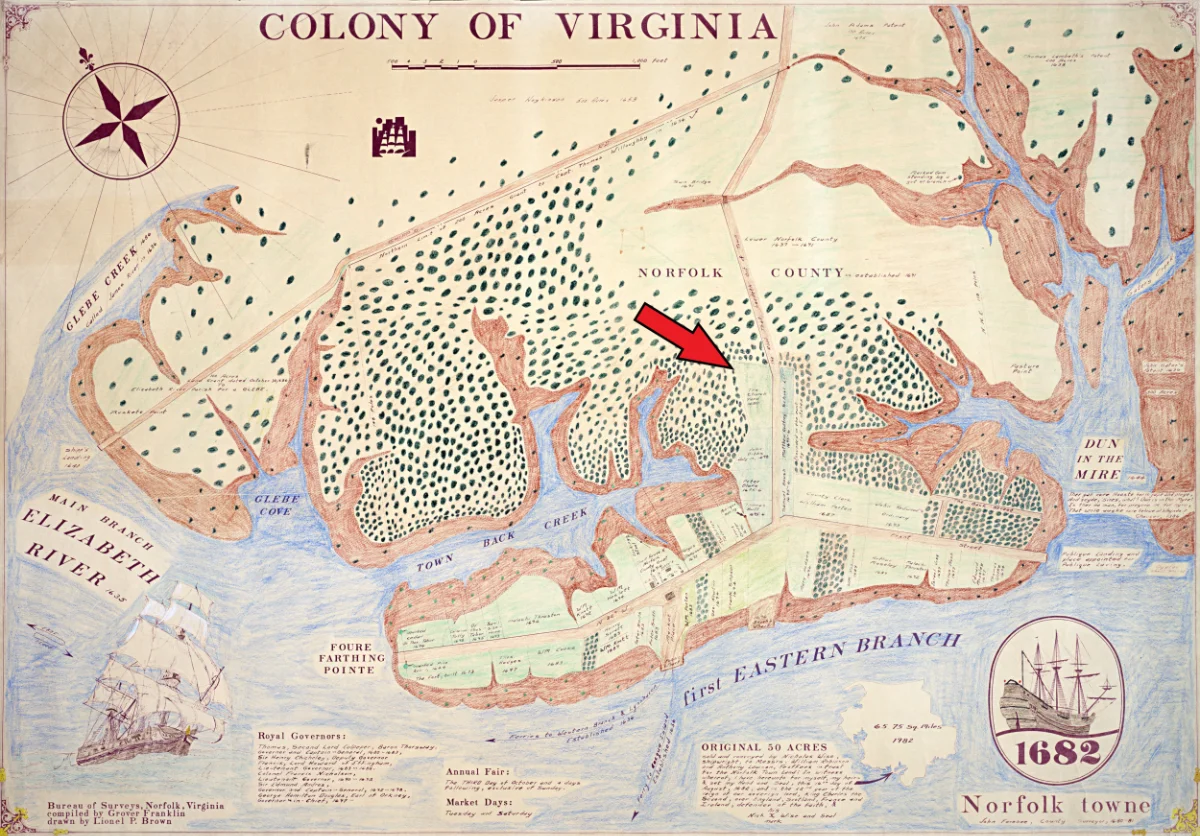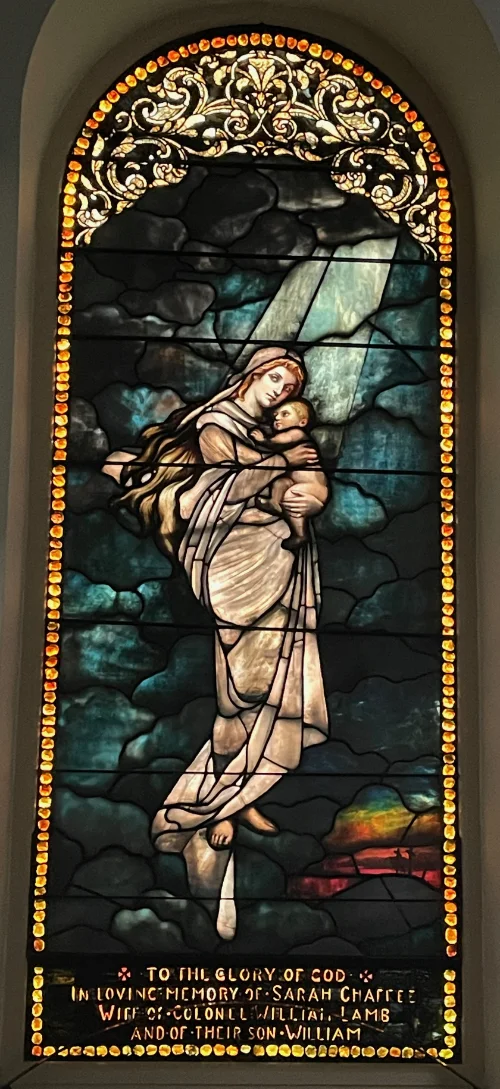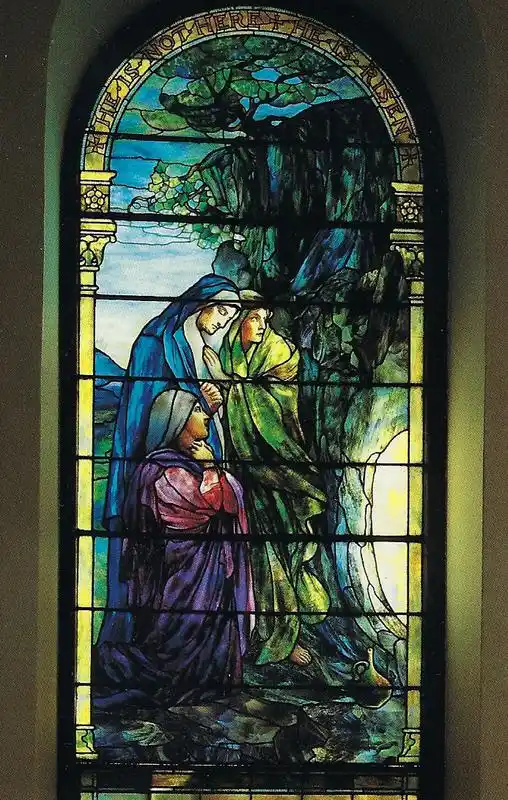History
Discover our history.
1624
1624
The Church of England was established in Virginia.
1636
1636
Charles I granted 200 acres of land to Thomas Willoughby. This property in what is now downtown Norfolk encompassed the original 50 acre town site (1682), including the current St. Paul’s property.
1636-1637
1636-1637
First Parish Church
The Elizabeth River Parish (created by the Virginia General Assembly in 1636 or 1637) established the first Anglican church of the new parish “at Mr. Seawell’s Pointe,” in the vicinity of the present Norfolk Naval Base.
1640
1640
Site selected for burying ground and church (this is the current St. Paul’s site).
1641
1641
Chapel of Ease
“Ye Chappell of Ease” was built near the Elizabeth River in the area that is now downtown Norfolk (actual location is unknown but some historians place it on our present site). After the church at Sewell’s Point was closed, the “chapel of ease” became the first Elizabeth River Parish church.
1673
1673
Date of the oldest tombstone remaining in the churchyard in the 1902 survey. Its inscription reads “Here lies the body of Dorothy Farrell who deceased the 18th of January 1673”. She was originally buried at Weymouth or Sandy Point, Va., and her grave (or gravestone) was later moved to St. Paul’s, probably by the Rev. Nicholas Okeson in July 1875.
1682

1682
Norfolk Founded
The town of Norfolk is established following an act of the Virginia General Assembly (1680) requiring each county to establish a 50 acre town site. The original 1680 survey included land set aside for a church and burying ground on the “road that leadeth out of town”. That site is the current St. Paul’s Church and churchyard. Click here to view the map.
1691
1691
Norfolk becomes the seat of Norfolk county. No more than a dozen families are living in Norfolk at this point.
1698-1700
1698-1700
Second Parish Church
The second Elizabeth River Parish church (a brick and wood building) was built on the southeast corner of our churchyard near the current intersection of St. Paul’s Boulevard and City Hall Avenue. It remained in use until approximately 1739 when the current building was completed.
1728
1728
COL Byrd
Colonel William Byrd II of Westover and his companions worshiped in the second parish church on March 3, 1728, when they were on their way to assist in the surveying of the boundary line between Virginia and North Carolina.
1728
1728
Norfolk Academy
The church receives a charter on November 13th to establish a school for boys on property across Church Street (St. Paul’s Blvd.) from the church yard. What was initially called the Grammar School would be renamed Norfolk Academy in 1787.
1736
1736
Norfolk Borough
Norfolk, growing in prosperity, is re-chartered as a borough on September 23rd. Samuel Boush was selected to be the first mayor, but he died before taking office. Norfolk was the only borough incorporated in colonial Virginia.
1739
1739
Nave Built
The Borough Church, the third parish church of Elizabeth River Parish (now St. Paul’s), was completed. It was the only house of worship in Norfolk until 1773 (and similarly our burial ground was the only public cemetery in Norfolk until the 1820′s).
1741
1741
Armed
In September the Board of Aldermen passed a resolution “that, for the future, the inhabitants of this Borough shall, to prevent any invasion or insurrection, be armed at the Church on Sundays, and other days of worship at Divine Service, under penalty of five shillings.”
1756-1763
1756-1763
French and Indian (Seven Years) War.
1759
1759
Wall
Church wall constructed (east side, now St. Paul’s Boulevard, and south side, now City Hall Avenue, are original). Bricks provided by Col. Samuel Boush.
1763
1763
Washington
Future president, George Washington stayed overnight in Norfolk on his return from a trip to the Great Dismal Swamp. Tradition says that since George Washington was in Norfolk on a Sunday (May 29, 1763), he likely attended Morning Prayer at the Borough Church, now St. Paul’s Episcopal Church.
1766
1766
A branch of the Sons of Liberty was formed in Norfolk on March 31 to protest the Stamp Act (1765). The effort was led by the Rev. Thomas Davis and included many members of the Borough Church.
1767
1767
The “Boston Massacre”. Crispus Attucks was the first African American to die in the cause of American freedom.
1771
1771
Lord Dunmore
In September, John Murray (Lord Dunmore) became the last colonial Governor of Virginia.
1775-1783
1775-1783
Revolutionary War
1775
1775
Battle of Great Bridge
On December 9, at the Battle of Great Bridge, Virginia and North Carolina militia defeated British Royal Governor Lord Dunmore and forced him to retreat to his warships in the Elizabeth River off Norfolk. His “floating city” of about 70 vessels also housed many of the Loyalist businessmen and families of Norfolk.
1776
1776
Cannonball
Between three and four o’clock in the afternoon on January 1st, Lord Dunmore, in retaliation for Norfolk’s refusal to supply provisions for his ships, ordered his fleet to fire on the town. The bombardment covered the entire waterfront. A cannonball, reputedly fired from the British twenty-eight gun frigate “Liverpool”, lodged in the church wall. Over the next two days, both British troops and Virginia and Carolina militiamen destroyed about two-thirds of the town. To prevent the British from occupying the town’s strategic location, Colonel Robert Howe’s colonial troops plundered and burned the remainder of the town on February 6. Only the walls of the Borough Church remained standing. Borough Church/St. Paul’s Church is the only pre-revolutionary building remaining in downtown Norfolk today.
1776
1776
Declaration of Independence
The Declaration of Independence, drafted by Thomas Jefferson, was accepted by the Continental Congress on July 4. On July 25 the Declaration of Independence was read on the courthouse steps in Williamsburg.
1781
1781
Hessian Fort
Hessian soldiers occupying Norfolk briefly use the thick, brick walls of the gutted building and church yard as a fort before marching to Yorktown.
1781
1781
Yorktown
General Lord Charles Cornwallis surrendered his army of 8,000 men to General George Washington at Yorktown on October 19.
1783
1783
The Treaty of Paris, signed on September 3, officially ended the Revolution and established American independence.
1785
1785
In October, the Virginia Assembly permits the holding of a lottery, to raise a maximum of $700, to rebuild the Borough Church of Elizabeth River Parish. The church was restored, including a new roof, and returned to active use in 1786.
1787
1787
The U.S. Constitution was drafted in Philadelphia. Virginia ratified the constitution on June 25, 1788, becoming the 10th state in the union.
1789-1803
1789-1803
Divided
The Borough Church is divided by two feuding congregations with two rectors. One faction formed Christ Church (now Christ & St. Lukes Church) while the other retained the building until 1803.
1800
1800
George Washington
A mock funeral commemorating of the death of George Washington was held in the Borough Church on February 22.
1803
1803
The Rev. William Bland died in May, and the Borough Church congregation scattered. Christ Church retained the title to the Borough Church property.
1805
1805
The building and property are occupied by Norfolk’s first Baptist congregation (a racially mixed congregation that was the predecessor to both First Baptist Church of Norfolk Kempsville and First Baptist Church of Norfolk Bute St.). They continued to worship there until 1827.
1812-1815
1812-1815
War
War of 1812
1813
1813
Craney Island
The Battle of Craney Island was fought on June 22nd. A victory for the United States during the War of 1812, the battle saved the city of Norfolk, and the adjacent city of Portsmouth, from British invasion.
1827
1827
Christ Church burned on March 9, and the congregation again used the old Borough Church building until its new building on East Freemason and Cumberland Streets was completed in 1828 (consecrated November 9). The old building was then used as a Sunday School for Christ Church until 1831.
1827
1827
By ordinance passed by the Common Council on August 7, the old burying ground at the Borough Church was closed to further burials of anyone except immediate relatives of those already buried there. Also in 1827 the Borough established a new public burying ground (now Cedar Grove Cemetery).
1832-1833
1832-1833
St Paul's
In 1832, Rev. Henry W. Ducachet of Christ Church and his congregation took responsibility for the rehabilitation of the old church. After work is completed in 1833, Bishop Richard Channing Moore reconsecrated it under the name Saint Paul’s Episcopal.
February 29, 1835
February 29, 1835
All interments in the “old burying ground” St. Paul’s Church yard were prohibited.
1845
1845
Norfolk City
Norfolk was incorporated as a City under Virginia legislation (February 13). It encompassed 13 square miles.
1846-1848
1846-1848
War
Mexican-American War
1848
1848
Cannonball
A cannonball, believed to be the one that had originally been lodged in the wall of the church, was discovered under ground beneath the depression in the wall. The vestry appointed a committee to have the ball permanently fixed in the wall of the church. It remains there today.
June - October 1855
June - October 1855
Yellow Fever
The ocean steamer Ben Franklin arrives in Hampton Roads with Yellow Fever on board. One third of the city’s residents died including Rev.Wm. M. Jackson, rector of St. Paul’s (Episcopal) Church, who gave his life assisting those afflicted. The Jackson Orphan Asylum for children of yellow fever victims was founded in his honor by St. Paul’s and Christ Churches.
1861 - 1866
1861 - 1866
In April Virginia became the eighth state to secede from the Union. The church was reorganized as the Protestant Episcopal Church of the Confederate States by Bishop William Meade. Returned to the PEC of the United States in 1866.
March 9, 1862
March 9, 1862
Virginia vs Monitor
The first battle between ironclads – the CSS Virginia and the USS Monitor – was fought in Hampton Roads nearby. The USS Merrimac, rebuilt as an ironclad and renamed Virginia, was built at the Norfolk Navy Yard.
May 10, 1862
May 10, 1862
Civil War
Mayor William Lamb (a parishoner of St. Paul’s) surrendered the City to Union troops. Federal forces under the command of General Benjamin Butler occupied Norfolk until 1865. St. Paul’s Church is used as a chapel for the Union Army from Oct. 1863 – Nov. 1865.
1870
1870
Robert E Lee attended services at St. Paul’s on May 4. Lee was staying at the home of Dr. William E. Selden (Surgeon General of the Confederate Army).
1870
1870
Parishioners of Christ Church and Saint Paul’s Church formed St. Luke’s Guild on May 5 to do missionary, educational, and charity in the community. This soon became St. Luke’s Episcopal Church (1872).
1870s
1870s
A three-tiered Victorian cast iron fountain was installed in the south churchyard. It was manufactured by J.W. Fiske and Company of New York. The maker’s mark is on the large bottom bowl.
1885
1885
The filling of Town Back Creek between Granby Street and the City Hall/Courthouse (now MacArthur Memorial) was completed, and City Hall Avenue was developed. Cove Street was later widened and incorporated into an extension of City Hall Avenue to Church Street (St. Paul’s Blvd.)
1888
1888
Description of Old St. Paul’s. “This old church and its God’s acre compose our Westminster Abbey. Here the worthy forefathers of our borough sleep”. Robert W. Lamb, Our Twin Cities . . ., p.150.
1892

1892
The Lamb stained glass window, made by the Hermann Company, was installed in the nave by Col. William Lamb in memory of his wife Sarah Chaffee and their son William. (Hermann was trained by Tiffany).
1906

1906
Tiffany Window
The Leigh stained glass window, made by Tiffany Studios, was installed in memory of Sarah Frances Leigh by her husband Capt. Robert B. Pegram.
1907
1907
Jamestown Exposition
St. Paul’s Episcopal Church is included as a featured attraction during the Jamestown Ter-Centennial Exposition in 1907.
1909
1909
On November 19 Saint Paul’s was visited by the First Lady of the United States. Helen Herron Taft was in Norfolk with her husband William Howard Taft, our 27th President (1909-1913). She took a tour of Norfolk, including Saint Paul’s, with her sister Mrs. Thomas Laughlin.
1909-1910
1909-1910
Parish House (St. Paul’s Memorial Hall) built in the Georgian revival style. The building was begun in the summer of 1909 and was completed in the spring of 1910. It was reported as built at a cost of between $18,000 and $19,000.
c. 1941
c. 1941
Captain Louis Mountbatten of the British Royal Navy was at the Norfolk Naval Shipyard. “On one of his trips to Norfolk, Lord Mountbatten was taken to see the Colonial cannonball imbedded in the wall of St. Paul’s Church. After inspecting the shot fired in 1776 by British ships under Lord Dunmore, Mountbatten quipped: ‘Hahnnh! Damn near missed it, didn’t he?'”
1951
1951
On November 18 General Douglas MacArthur, with his wife and son, attended a morning service at Saint Paul’s. Afterwards they participated in the dedication of a memorial park on the site of Riveredge in Berkley, the home of his mother Mary Pinkney Hardy MacArthur.
1958
1958
Borough Church/Old St. Paul’s Church recorded in Historic American Buildings Survey in January.
1964
1964
General MacArthur
GEN Douglas MacArthur’s funeral service was held at St. Paul’s on April 11th. Attorney General Robert F. Kennedy and his wife attended representing the president.
1969
1969
USS Norfolk
The Laying Up of Ship’s Colors ceremony was held at St.Paul’s for the USS Norfolk on May 22nd.
1971
1971
VLR Listing
St. Paul’s Church was listed on the Virginia Landmarks Register (#122-0025) and the National Register of Historic Places (#71001058).
1976
1976
Bicentennial of the American Revolution
The Bishop of London was present to help St. Paul’s celebrate the Bicentennial of the American Revolution. He preached a sermon here on Thursday January 1, 1976 (Ecumenical Service of Thanksgiving).
1982
1982
150th Anniversary
On May 9 St. Paul’s celebrated the 150th anniversary of the renaming of the church (on May 7, 1832).
1984-1985
1984-1985
18th Century Reredos
An 18th century reredos, (c. 1750’s) was given to St. Paul’s by St. John’s Church in Hampton. It was restored and installed in St. Paul’s. This reredos, or altar piece, was originally made for Stratton Major Parish Church in King and Queen County. When that church was demolished in the 19th century, the reredos was placed in St. John’s Church in West Point. It was too large for the building, blocking the windows. Then it was given to St. John’s Church in Hampton, which could not use it because it would have required extensive renovations.
1989
1989
250th Anniversary of the Borough Church
The Borough Church 250th anniversary was celebrated this year. The first anniversary service was held January 29 (Saint Paul’s Sunday). It emphasized the spiritual and secular roles of the church. Mayors and other City officials were preceded in procession by the 1753 Norfolk civic mace, as was the colonial custom. A video (VHS) was produced.
1994
1994
New Windows Installed
Ten colonial style clear glass windows were installed in the church, replacing Austrian colored glass windows that had been added during a Victorian restoration
1998
1998
Cannonball Trail Proposed
The City’s Update to the Downtown Norfolk 2000 Plan proposed the Cannonball Trail, a new pedestrian heritage trail connecting historic sites, historic markers, major districts, and contemporary attractions in downtown. The trail’s namesake is the St. Paul’s cannonball.
2000
2000
Cannonball Trail Dedicated
The Cannonball Trail, connecting historic sites and public attractions in downtown Norfolk, was dedicated on June 30 at St. Paul’s.
2007
2007
Brock Memorial Organ Dedication Concert
The dedication concert for the new M. Foscue and Clara P. Brock Memorial Organ, held November 18 was performed by internationally acclaimed concert organist Thomas Trotter. Mr. Trotter was appointed City Organist for Birmingham, England in 1983, where he is also Artistic Advisor and Resident Organist at Birmingham’s Symphony Hall. The organ was dedicated earlier that Sunday (November 18) at the 10:30 service.
2013
2013
The Bell
In July Saint Paul’s acquired a bell, through Bishop Hollerith, from St. Mark’s Episcopal Church in Cochran, Virginia, which had been deconsecrated in 2008. It was made in 1917 by the McShane Bell Foundry Company of Baltimore. The inscription on the front of the bell reads “Whene’er the sweet church bell peals over hill and dell, may Jesus Christ be praised.” The bell was restored in December.
2016
2016
Bell Installed
On December 21 our recently acquired bell was installed on the chapel roof by the McShane Bell Foundry Company of Baltimore. It has been programmed to ring on the hour from 9:00 to 5:00 Monday through Saturday and before the two Sunday services. It can also be rung for weddings, funerals, and other special events.
2020
2020
18th Century Service and Re-enactment
On February 23 an 18th century service and re-enactment was held in the church by Timothy Platek, portraying the Reverend/Chaplain Thomas Davis, rector of the Borough Church 1773-1776.
2023
2023
The Rt. Rev. Fanuel Magangani
On June 16 Saint Paul’s held a Shindig to welcome the Rt. Rev. Fanuel Magangani, Bishop of Northern Malawi in Central Africa. At our June 18 service, Bishop Magangani was our preacher and celebrant.